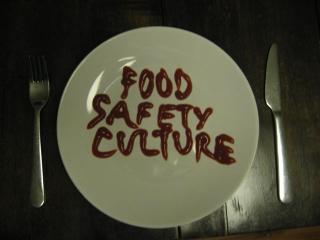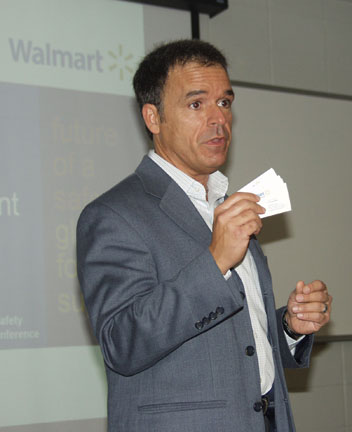
Everything I knew about the UK I learned after being subjected to Coronation St., Are You Being Served and Austin Powers. The first two I was subjected to on a weekly basis during my formative years; the third one was funny back when Mike Myers was still cool. Through the Brit coms and Corry St. characters (whom mostly I couldn’t understand) I learned about pub fare including savoury pies, bangers and mash and mushy peas. This week, I got to live it.
I was in London to speak at the Global Food Safety Conference, which had a food safety culture theme.  Friend of barfblog and food safety culture guru Frank Yiannas (right exactly as shown) kicked off the conference. During his talk he said that creating a culture of food safety is really about shared core values and food safety shouldn’t be described just as a priority (because these change). Frank also talked about traceability and stressed transparency of measures and practices — that they need to be shared with suppliers, buyers and ultimately the folks who buy and eat the products. So, like, pull back the Wizard of Oz curtain, market what you do, and proactively engage society in discussions around risks.
Friend of barfblog and food safety culture guru Frank Yiannas (right exactly as shown) kicked off the conference. During his talk he said that creating a culture of food safety is really about shared core values and food safety shouldn’t be described just as a priority (because these change). Frank also talked about traceability and stressed transparency of measures and practices — that they need to be shared with suppliers, buyers and ultimately the folks who buy and eat the products. So, like, pull back the Wizard of Oz curtain, market what you do, and proactively engage society in discussions around risks.
Through conversations I had and sessions I attended I’ve gleaned this from the conference:
– Food safety culture is now a buzz term, and while definitions are still taking shape I’m not sure how many folks have figured out how to create and foster it within their businesses. To me it’s all about folks from the front lines and middle managers to executives knowing about risks, what to do about them and being able to demonstrate that they are addressing them.
– A bad food safety culture is easier to define than a good one. Lots of elements of a good food safety culture were presented (internal programs, supplier verification stuff, targeted training) but no one I saw really pulled it all together.
– According to consumer surveys, that have their limitations, trust in the industry and government’s ability to manage food safety is fairly low; my guess is that some of this can be linked the lack of transparency around food safety, getting back to the market/engage consumers about risk stuff.
I spoke on development and evaluation of food safety infosheets, you can find my slides here. Best question I received was based on our work, did I think a company should remove their "employees must wash hands" signs. My reply was it would be nice to evaluate whether they worked or not to achieve better handwashing first. But maybe, yeah. I should probably added putting up our infosheets in place might be a good strategy. But like in Seinfeld, I often think of better responses after the event.
 I had a chance to visit a couple of pubs, ate fish, chips, mushy peas and a pie; got some local draft beer; and, witnessed a barkeep attempt to sneak up and shave one of his customer’s heads. So my out-of-conference London experience was pretty much exactly like Austin Powers.
I had a chance to visit a couple of pubs, ate fish, chips, mushy peas and a pie; got some local draft beer; and, witnessed a barkeep attempt to sneak up and shave one of his customer’s heads. So my out-of-conference London experience was pretty much exactly like Austin Powers.
